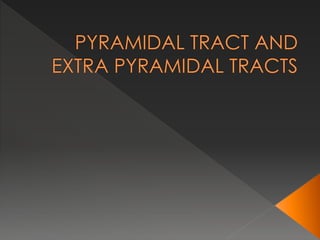
Pyramidal tract and extra pyramidal tracts
- 3. Tracts originating from the brain and descending in to spinal cord These tracts are concerned with various motor activities of body Two groups › Pyramidal tract › Extra pyramidal tract
- 4. Aka corticospinal tract Contains axons of cell bodies present in motor cortex of brain. Pyramidal cells of Betz Origin :- 30% from primary motor cortex (Area 4) 30% from premotor area and supplementary motor cortex 40% from the somatic sensory area
- 8. The fibers descend as a part of corona radiata Then pass through the posterior limb of internal capsule Then downwards through the brainstem Forming pyramids in the medulla At the lower part of medulla 90% of the fibers decussate in the midline to reach opposite side Forming two separate tracts from here
- 11. Constituted by crossed fibers Descends in the lateral white funiculus of opposite side These fibers terminate in the internuncial neurons of spinal grey matter. Internuncial neurons synapse with motor neurons in anterior horn cells Some fibers end directly on the AH cells Axons of AH cells supply skeletal muscle through spinal nerve
- 12. Formed by the uncrossed pyramidal fibers They descend thro ant white funiculi on same side They reach only till mid thoracic region On reaching appropriate spinal segment they cross to the opposite side Terminate in the same way as lateral corticospinal tract
- 13. In brainstem some fibres terminate in motor nuclei of cranial nerve They cross to opposite side at various levels of brainstem depending upon the nuclei Which supply muscles of face
- 14. Both the anterior and lateral corticospinal tracts ultimately innevate opposite side of the body i.e Fibres from the right lobe of cerebral cortex terminate on the left AH cells
- 15. UMN :- neurons giving origin to pyramidal tract LMN :- AH cells along with their neuron constitutes LMN
- 16. Fibres of CS tract are unmyelinated at birth Myelination begins at 2nd week after birth and completes at 2years of age Contains large fibres and small fibres Large fibres disappear at old age leading to shaky movements
- 17. Cerebral cortex controls voluntary movements of the body thro CS tract Lesion produce paralysis of concerned muscle group Sends collateral to other motor control systems like basal ganglia , cerebellum ..
- 18. Descendings tracts other than pyramidal tract are called extra pyramidal tracts › Rubrospinal tract › Vestibulospinal tract › Reticulospinal tract › Tectospinal tract › Olivospinal tract › Medial longitudinal fasciculus
- 22. Origin:- arises from nucleus magnocellularis or red nucleus in midbrain Course :- fibres cross to the opposite side in the lower part of tegmentum of midbrain After that follows a course similar to lateral CS tract Termination :- on the interneurons along with CS tract
- 23. Facilitates flexor muscles and inhibit extensor muscles Red nucleus receives corticorubral fibres from ipsilateral motor cortex Cortico-rubro-spinal tract acts as a alternate route of pyramidal tract Reaches only upper three cervical segments
- 27. Lateral Vestibulospinal Tract:- origin from lateral vestibular nucleus (deiter’s) at lower pons fibres are somatotopically arranged in this nucleus Course :- tract is uncrossed and lies in the ant funiculi They terminate on alpha and gamma motor neuron thro interneuron
- 30. Vestibular nucleus receives afferents from vestibular apparatus mainly from utricle Adjustment of postural muscles to linear acceleration Facilitates extensor muscles and inhibits flexor muscle Maintenance of balance
- 31. Fibres originates from medial vestibular nucleus Descends thro the anterior funiculi and mostly uncrossed Fibres ends in AH cells either directly or thro interneuron Receives inputs from vestibular apparatus mainly from semicircular canals Controls movements of head with respect to auditory and visual stimuli .
- 32. Two divisions Medial – pontine Reticulospinal tract Lateral – medullary Reticulospinal tract pontine Reticulospinal tract:- arises from medial pontine reticular formation and descends mostly uncrossed and terminates in alpha & gamma motor neurons in spinal cord thro interneurons
- 33. Fibres orginates from medullary reticular formation (gigantocellular) , descends mostly uncrossed in the lateral funiculi and terminates in same way as pontine RS tract
- 35. Reticular formation Receives afferents from cortex Forming cortico-reticulospinal pathway Control of movements and muscle tone Also convey autonomic fibres from higher center to spinal cord
- 36. Pontine and medullary nuclei functions opposite to one another in controlling › Muscle tone › Respiration › Vascular caliber › Antigravity muscles posture
- 37. Fibres originates from superior colliculi Fibres cross the midline at tegmentum of midbrain (dorsal tegmental decussation) And descends thro anterior funiculi Terminates in AH cells of upper cerviccal levels Functions :- turning head and moving arms in response to visual or other stimuli
- 38. Originates from inferior olivary nucleus Descends uncrossed and terminates in AH cells May control reflex muscle activity Tract is of doubtful existence
- 40. Extends from midbrain downwards Fibres takes origin from › Vestibular nuclei › Reticular formation › Superior colliculus › Interstitial nucleus of cajal › Posteriior commisure › Has connection Cranial nerves 3, 4, 6, 7 , 8, 12 AH cells of muscles of neck Function :- harmonius movement of eye and neck
- 44. Upper Motor Neuron paralysis :- paralysis of UM neurons Lower Motor Neuron Paralysis :- paralysis of LM neurons
- 47. Monoplegia :- paralysis of all muscles of one limb Hemiplegia :- paralysis of one half of body Paraplegia :- paralysis of both lower limbs Quadriplegia :- paralysis of all four limbs